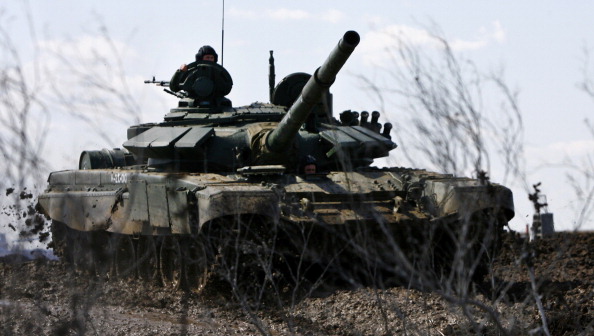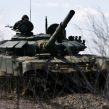
A Global ‘Resources War’ Begins: ‘Hot’ on Some Fronts, ‘Cold’ on Others
Publication: Eurasia Daily Monitor Volume: 11 Issue: 179
By:

Next month (November 2014), it will be 25 years since the fall of the Berlin Wall, which ended the Cold War. But a new cold war is apparently swiftly taking shape between the East and the West. Notably, the Ukrainian crisis continues to unfold into something reminiscent of the proxy regional wars in the Middle East, Asia, Africa and Latin America, which were an essential part of the last great global, ideological standoff. Today, as during the Cold War, misconceptions dominate strategic decision making on both sides of the newly forming global divide. Western politicians and observers are trying to guess what Russian President Vladimir Putin will do next: Will the Russian-led forces begin another offensive in southeastern Ukraine to form a land corridor to Crimea, or will they move on other fronts (Dozhd, October 6)?
Equally unclear is whether Russia is reacting to presumed sudden threats or whether its massive military actions in Ukrainian were preplanned. No one seems to fully understand why the Kremlin went berserk over Ukraine and what the West could do to effectively change Russian policies and practices. A new PR scarecrow has been erected in the West—“hybrid warfare,” which was used to destabilize Ukraine but that effectively caught Western military planners and political leader unprepared. Both Moscow and Kyiv are visibly struggling to fully understand the Western obsession with hybrid warfare. Infiltration, diversion and insurrection—used last March by Moscow to take over Crimea and somewhat less effectively in April and May in the Donbas region of eastern Ukraine—are more or less classical military tactics. In any case, hybrid warfare in Ukraine ended last June as infiltration and insurrection were replaced by increasingly regular army warfare. Nonetheless, mutual East-West misconceptions and misunderstandings over the hybrid warfare issue prevail unabated (Vedomosti, September 3).
Despite the ceasefire agreement in Donbas, signed in Minsk on September 5, pitched battles and shootings continue in Donetsk, where the Russia-backed rebels have for weeks been attempting to fully take over the local international airport. The battle for the Donetsk airport and other decisive battles in Donbas in the last couple of months are anything but hybrid: Tanks, heavy guns, mortars, multiple rocket launchers, sustained artillery barrages and ugly trench warfare have all been persistent features of the war (Komsomolskaya Pravda, October 5).
In Russia, traditionally the General Staff of the Armed Forces has been the main center of long-term strategic planning—both during the Cold War and today. Defense development required massive and long-term nation-wide investment to build and expand military capabilities to meet the threats of the future. In the Soviet Union, armament development plans dictated social, economic, internal and foreign policy changes. Today, Putin’s main obsession seems to be the massive rearmament program aimed at spending some 23 trillion rubles this decade to 2020. This amount is further enlarged by the need to replace components and materials Russia had previously procured in the West and in Ukraine (known as import replacement or “importozamescheniye”) (kremlin.ru, September 10).
Last year, speaking at a defense conference in Moscow, the chief of the General Staff, Army General Valery Gerasimov, outlined the overall vision of future threats his staff is planning to meet with massive rearmament efforts. The General Staff believes that by 2025–2030, the world will be engulfed by a wave of “resources wars.” Apparently believing the entire globe has again fallen into the so-called Malthusian trap, Russian military planers believe that industrial production and population growth will make natural resources less and less available, leading to “resources wars,” violent revolutions, global epidemics and general destabilization. Russia, which controls a large landmass and untapped multiple resources, including oil and gas in the Arctic, may attract foreign aggressive military pressure from all strategic directions, with the United States leading the pack, he argued (RIA Novosti, February 14, 2013). In his presentation, Gerasimov mentioned the enhanced role of “nontraditional” (a.k.a. hybrid) warfare that uses civil unrest, information war tactics and so on. But the main thrust of Russia’s long-term preparation is a regular military upgrade with strategic offense and defense—the main focus.
The Ukrainian crisis is seen in Moscow in essence as a major US-led attempt to preempt Russian long-term strategic defense preparation plans. Strategic thinkers in Russia believe the US wants to turn Ukraine into a possible future forward base of operations as well as negate Russian attempts of military rearmament by using the Ukrainian crisis to stop the supply of Ukrainian military and double-use components, while imposing sanctions to stop the supply of Western-made materials. As Putin told reporters last month (September), after the European Union imposed an expanded package of sanctions: “Why are new sanctions imposed? I believe Ukraine per se is not the main factor, but is used as an instrument by the US to revive NATO [the North Atlantic Treaty Organization] and unite its satellite nations by creating an outside threat” (kremlin.ru, September 12).
The conspiracy-obsessed Russian elite is sincerely preparing to fight a global “resources” war with the US and its “satellites” in some 10–15 years. They presume Washington is also already preparing for the same type of conflict, maneuvering to isolate and weaken Russia, surround it with hostile states, promote internal dissent, and freeze its essential military modernization—in essence softening up the future prey before going in for the kill. Russian actions are clearly seen in the Kremlin as defensive in nature: to swiftly take over Crimea before US/NATO forces manage to land in Sevastopol; to use economic, financial and military pressure to ensure Ukraine stays in Moscow’s sphere of influence; to clamp down on dissent, press and Internet freedom internally; and to curtail foreign influence.
After the fall of Communist rule, the main preoccupation of the Russian elite has been bloody internal turf wars over control of natural resources and the distribution of resource rents that fill state coffers—all while also lining the pockets of oligarchic rulers. This Russian culture of turf resource wars is, in turn, projected on the international political scene: everyone in the world is seen as fighting for natural resource rents as the ultimate source of universal wealth, and the Kremlin must do what it takes to defend its share. Russian policies and actions are predictable and logical within the frame of this Kremlin-specific worldview. According to Moscow, the global “resource war” is already in full swing, and on some fronts it is already “hot,” while on others it remains “cold.”




